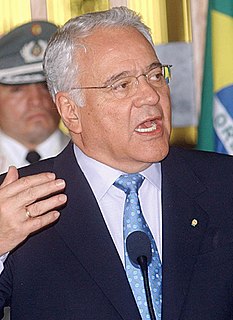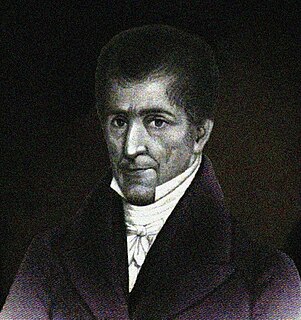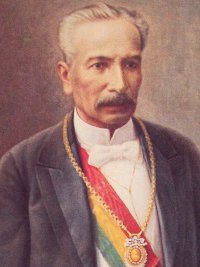
The politics of Bolivia takes place in a framework of a presidential representative democratic republic, whereby the president is head of state, head of government and head of a diverse multi-party system. Executive power is exercised by the government. Legislative power is vested in both the government and the two chambers of parliament. Both the Judiciary and the electoral branch are independent of the executive and the legislature. After the 2014 election, 53.1% of the seats in national parliament were held by women, a higher proportion of women than that of the population.

The President of Bolivia officially known as the President of the Plurinational State of Bolivia, is head of state and head of government of Bolivia. According to the current Constitution, the president is elected by popular vote to a five-year term, renewable once. In 2016, in a referendum the country voted to maintain term limits. Since 2009, if no candidate wins a majority, the top two candidates advance to a runoff election. Prior to 2009, if no candidate won half the popular vote, the president was chosen by a vote in a joint legislative session from among the top two candidates.
In United States presidential elections, an unpledged elector is a person nominated to stand as an elector but who has not pledged to support any particular presidential or vice presidential candidate, and is free to vote for any candidate when elected a member of the Electoral College. Presidential elections are indirect, with voters in each state choosing electors on Election Day in November, and these electors choosing the President of the United States and Vice President of the United States in December. Electors today are elected in every state by popular vote, and in practice have since the 19th century almost always agreed in advance to vote for a particular candidate — that is, they are said to have been pledged to that candidate. In the 20th century, however, several elections were contested by unpledged electors, who made no pledge to any candidate before the election. These anomalies largely arose over fissures within the Democratic Party over the issues of civil rights and segregation. No serious general election campaign has been mounted to elect unpledged electors in any state since 1964.
Limited voting is a voting system in which electors have fewer votes than there are positions available. The positions are awarded to the candidates who receive the most votes absolutely. In the special case in which the voter may vote for only one candidate and there are two or more posts, this system is called the single non-transferable vote or sometimes the strictly limited vote.

Elections in Bolivia gives information on elections and election results in Bolivia.

The Alberta general election of 1921 was the fifth general election for the Province of Alberta, Canada. It was held on July 18, 1921, to elect members to the 5th Alberta Legislative Assembly. It was one of only four times that Alberta has changed governments.

The Plurinational Legislative Assembly is the national legislature of Bolivia, placed in La Paz, the country's seat of government.
Eliodoro Camacho (1831–1899) was a noted Bolivian politician, party leader, and presidential candidate. The Eliodoro Camacho Province is named after him. Camacho was born in Inquisivi, Department of La Paz, but grew up in Cochabamba. He founded the Liberal Party, which espoused freedom of religion, a stricter separation between church and state, legal acceptance of civil marriages and divorce, and strict adherence to democratic procedures. Camacho also participated as an officer in the 1879-80 War of the Pacific against Chile, and later played a key role in the 1880 Constitutional Convention. Following the establishment of the new post-war order, he led the opposition against the Conservatives. He ran for president in 1884, 1888, and 1892.

General Narciso Campero Leyes was president of Bolivia from 1880 to 1884. The Narciso Campero Province was named after him.

The Vice President of the Plurinational State of Bolivia or Vice President of Bolivia, is the second highest political position in Bolivia. The Vice President replaces the President in his definitive absence or others impediment and is the President of the Legislative Assembly.

Severo Fernández Alonso Caballero was President of Bolivia from 1896 to 1899. He is best remembered as the last president of the 15-year period of Conservative Party hegemony (1884–99).

General elections were held in Bolivia on 30 June 2002. As no candidate for the presidency received over 50% of the vote, the National Congress was required to elect a President. Gonzalo Sánchez de Lozada was elected with 84 votes to the 43 received by Evo Morales.

General elections were held in Bolivia on 7 May 1989. As no candidate for the presidency received over 50% of the vote, the National Congress was required to elect a President on 6 August. Although the Revolutionary Nationalist Movement had received the most votes, its candidate for President Gonzalo Sánchez de Lozada was defeated by Jaime Paz Zamora of the Revolutionary Left Movement (MIR) in the Congressional vote, despite the MIR only finishing third in the public vote.

The Bolivian general election, 2014 was Bolivia's second to take place under the country's 2009 constitution, and the first supervised by the Plurinational Electoral Organ, a newly created fourth branch of government. Incumbent President Evo Morales was re-elected for a third term.

General elections were held in Bolivia in 1884. Gregorio Pacheco of the Democratic Party received the most votes in the presidential election, whilst the Liberal Party emerged as the largest party in Congress.
An indirect election took place in Estonia in 2016 to elect the president of Estonia, who is the country's head of state. The Riigikogu — the Parliament of Estonia — elected Kersti Kaljulaid to be the next head of state of Estonia to succeed Toomas Hendrik Ilves, who had served his second and final term as president. Kaljulaid is the first female head of state of Estonia.

General elections were held in the Federal Republic of Central America in 1825 to elect the President of Central America as the 1824 Central America Constitution established. The liberal-dominated Congress called upon the election which was held in all five member states; Costa Rica, El Salvador, Guatemala, Honduras and Nicaragua. The two main parties were the Liberals and the Conservatives.












